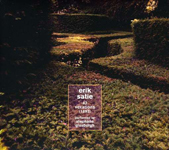|
|
 |
Dusted Reviews
Artist: Erik Satie Album: 42 Vexations (1893) Label: Sub Rosa Review date: Nov. 16, 2009 |

|
|
|
 |
As detailed in this disc’s accompanying essay by Matthew Shlomowitz, Vexations would have remained a possibly forgotten and probably unplayed piece of Erik Satie’s oeuvre were it not for John Cage. The composition, which consists of the same short phrase played on the piano 840 times, resulting in over 18 hours of proto-minimalism that might have been a joke when Satie conceived of it, but has grown, in some circles, into what might be the composer’s most notorious work. Vexations is enigmatic, to be sure: some debate whether the composition was ever meant to be performed or was simply a conceptual exercise, and conjecture remains as to whether the 840 iterations of the composition’s sole motif are necessary to its performance, or merely a suggestion from Satie. His vague indication of tempo has even led to disparity in the piece’s length; it has taken as long as 28 hours to perform in full. The piece is handled on this disc in excerpt form by Belgian Stephane Ginsburgh, who has previously performed piano works by Morton Feldman, Marcel Duchamp and others for the Sub Rosa imprint. Clocking in at 69 minutes, 42 Vexations, as the liner notes mention, needs 12 repeated plays to reach the 840 mark, but even this sliver of the full piece gets its point across adequately enough.
Vexations was written as a piece of Musique d’Ameublement (furniture music), Satie’s name for music that is meant to be a part of the listener’s surroundings, functioning as an atmospheric touch, not something to be paid attention to so much as a not-always-noticed tonal influence on a space. Some have keenly observed that in this, Satie had created the world’s first muzak, but a piece like Vexations isn’t in the same league as instrumental Manilow. Were Vexations to be played in your local department store (if a department store is lucky to still exist in your town), it likely wouldn’t take long for the average shopper to notice that something was up. In this way, the composition no longer serves its original purpose: While it might be easy to ignore, the repetition of the piece makes it rather noticeable, and what was at least partially meant as background sound is now performed and discussed more as an endurance test for both the listener and performer. Nowhere is this so obvious as in Vexations premier performance in September 1963, where the piece was famously performed by John Cage, John Cale, Christian Wolff, James Tenney and others. The longer a participant stayed, the less they paid in admission, with those who stayed long enough even coming out ahead on the deal and making money. One man, Karl Schenzer, made it through to the end, and Vexations had been used as a far more demonstrative tool than its composer appeared to intend.
Ginsburgh’s interpretation of the Satie score is hardly provocative, played softly, and at a pleasingly unhurried pace. The single motif that makes up the piece does an odd job of shape-shifting as it is repeated: what sounds plaintive on one go-around is ominous at the next, and might gain even a bit of levity 20 minutes later. Of course, Ginsburgh’s no robot, so there’s variation in his playing, but, as it unfolds, the piece becomes as much about the listener as it is about the performer. Attempts to pay close attention don’t necessarily offer a payoff. Vexations is what it is – starkly simple and complexly enigmatic all at once.
By Adam Strohm
|







